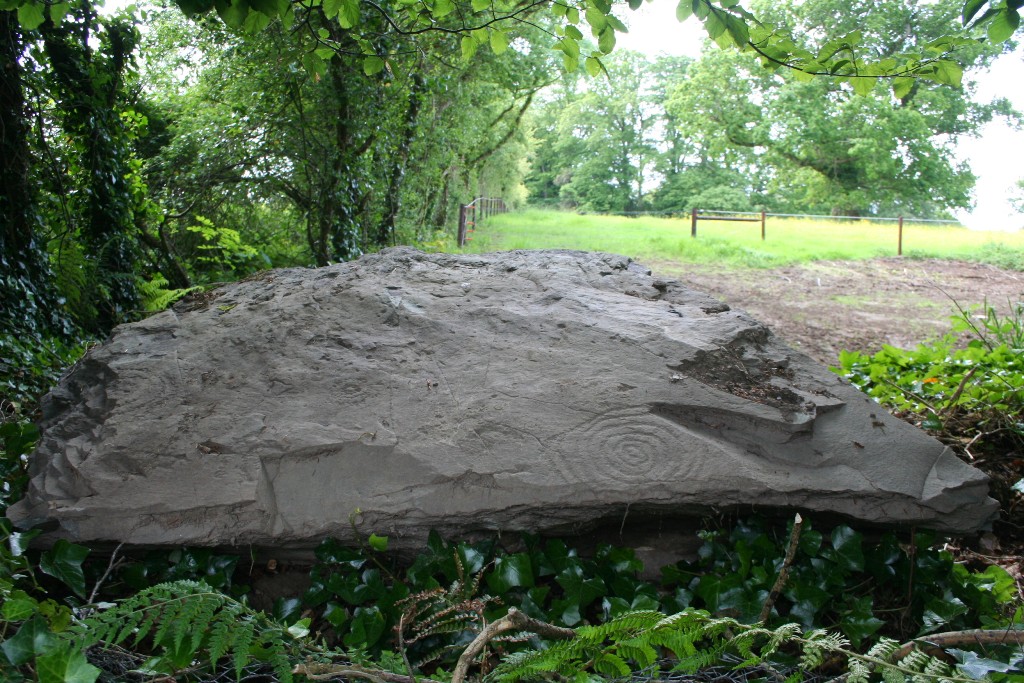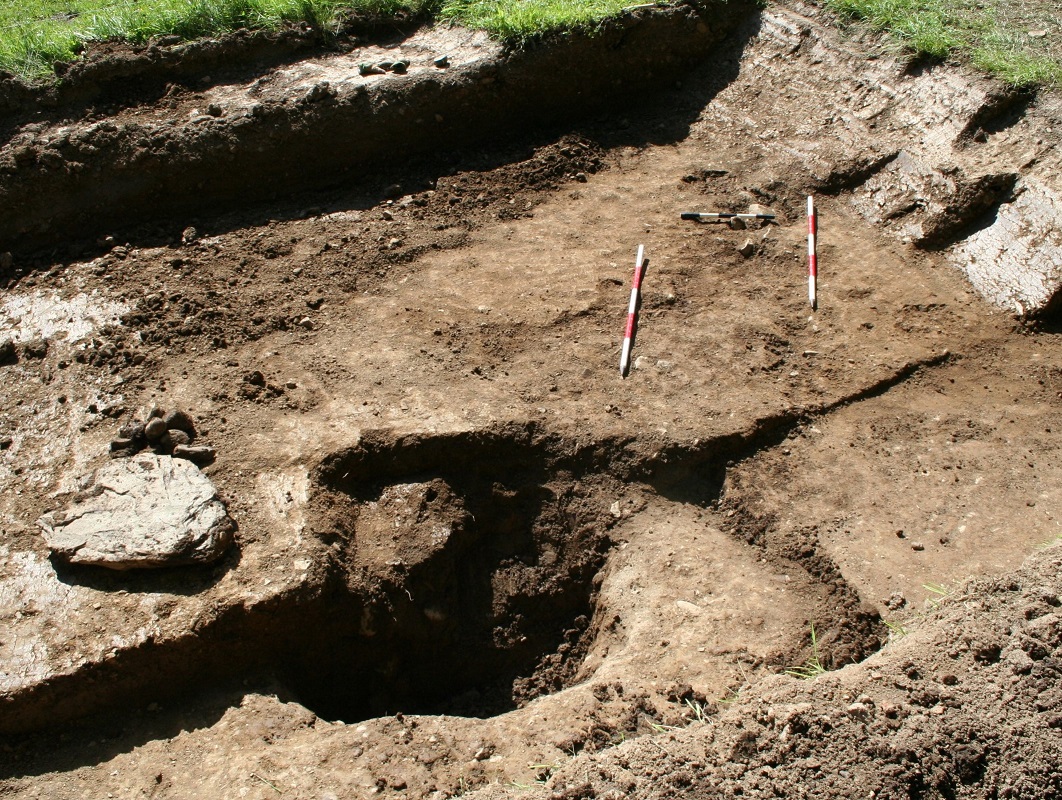County: Meath Site name: Dowth Hall, Dowth
Sites and Monuments Record No.: ME020-013 Licence number: 14E0047
Author: Finola O'Carroll CRDS
Site type: Prehistoric to modern
Period/Dating: —
ITM: E 702891m, N 774012m
Latitude, Longitude (decimal degrees): 53.705649, -6.441593

Testing was carried out at Dowth Hall, Dowth, Co. Meath. Dowth Hall is situated on a ridge overlooking the River Boyne. It is approximately 660m east-north-east of the great passage tomb at Dowth (ME020-017003) and some 310m west-south-west of the henge (ME020-010) at the eastern end of the ridge. It is within the UNESCO World Heritage Site, Brú na Bóinne (http://www.worldheritageireland.ie/fileadmin/user_upload/ documents/BrunaBoinneWHSResearchFramework.pdf).
Approximately 1300m of trenching was needed to carry services to different locations around the main house and to the various buildings on the property (Fig. 1-Main image). Testing was carried out on various days between 3 March 2014 and 18 February 2015 and excavation and recording of a pit feature found in testing occurred between 26–28 June 2014.
Geophysical prospection in relatively undisturbed ground was requested by the National Monuments Service. Geophysical survey was undertaken by Ms. Joanna Leigh of J.M.Leigh Surveys (Licence No. 14R0027) in advance of testing in two locations, one in greenfield to the north of the house and one to west of the house; both surveys suggested some possible features. Two were noted in the field to the north of the house: a possible bank was not found in testing, but the second feature, noted as a possible trend rather than a feature, was probably coincidental with the older ‘Back Avenue’ to the house. In the second survey area alongside the Farm Lane to the west and south of the house, geophysics had highlighted possible features in the vicinity of ME020-13, passage tomb. Overall, test excavations confirmed a number of features noted on the 1st and 2nd Editions of the OS maps, especially those relating to original avenues. Test trenching immediately to the east of the house indicated that the ground level rises naturally towards it, so that is the locally highest point. No archaeological features were found but three pieces of quartz, averaging between 0.17m and 0.25m in length were recovered from the trench in front of the house, and a fourth was found a little way back down the avenue. The quartz stones were in the interface of topsoil and subsoil. Large greywacke blocks were noted immediately to the rear (west) of the house, between it and the damaged cairn/mound, (ME020-12), suggesting that a structure incorporating greywacke orthostats had been impacted on by the original construction of the house. A ha-ha separated the level terrace in front of the house from the field to the east in which the large henge (ME020-10) is located. An elongated hollow running east-west at the southern side of this field was topsoil stripped and filled in. A long east-west running ridge was visible in the LiDAR survey. This was not apparent on the ground, but the northern limit of the topsoil strip at the western end exposed a dump of brick and stone, possible a relict avenue extending towards the henge. During this time a large greywacke boulder, found initially in a secondary position face down near the ha-ha and then moved close to the road, was discovered to have significant megalithic art on it (Plate 1—above), and was reported to the NMS. This has now been moved and safely displayed under glass on the property.
The test trenching alongside the farm lane running north-south to the west of the house revealed a pit close to the passage tomb ME020-13 which proved to contain a large piece of undecorated greywacke. This was subsequently excavated as it was going to be impacted upon and the geophysical survey had indicated the presence of adjacent features which were then partly revealed by a topsoil strip of an area 6m x 6m adjoining the pipe trench (Plate 2—below). The pit was an oval shaped feature 1.52m north-south x 1.15m in plan, with a minimum known depth of 1.15m below the modern grass level. Its fill was an homogenous clay with occasional charcoal inclusions, and in appearance suggested that it was composed of the natural clay which had been dug out and then filled back into it without any significant addition of organic or humic material. A broken flint flake was found in the north-easern quadrant of the pit. There was a defined cluster of predominantly sandstone cobbles focussed at the centre and towards the base of the pit which suggested that they had been deliberate placed. The large piece of greywacke, with one weathered and one fractured face, suggests that it was a fragment from a larger stone which was broken up or damaged. The combined evidence of the lack of organic fill coupled with the presence of deliberately inserted cobbles suggests that the pit was dug to receive a large post or standing stone, which was subsequently removed or destroyed. There is no indication that a large post rotted in situ. The large piece of greywacke, which itself appears to have signs of ancient breakage, suggests that it was either part of the chocking arrangement for a large post or standing stone, or is a broken off piece from a larger stone that may have stood there. Given the fact that greywacke cleaves leaving relatively flat faces, its shape is not a real indication of the form of the larger piece from which it came. A small quantity of charcoal was retrieved from the fill; there were some small pieces of roundwood identified as prunus avium padus and thus suitable for dating. A date of 3599+/-32 BP, (2033 – 1884 cal BC; UBA 30267) was returned which provides a point in time for activity in the pit. It may date the digging of the pit and the insertion of whatever it was intended to hold, or it may date the removal/destruction of whatever was there; it is difficult to tell which, though the fact that the charcoal was in the lower fill may tally with a construction rather than a destruction date. All testing, excavation and post-excavation costs were borne by Devenish Nutrition.

Greenanstown, Stamullen, Co. Meath